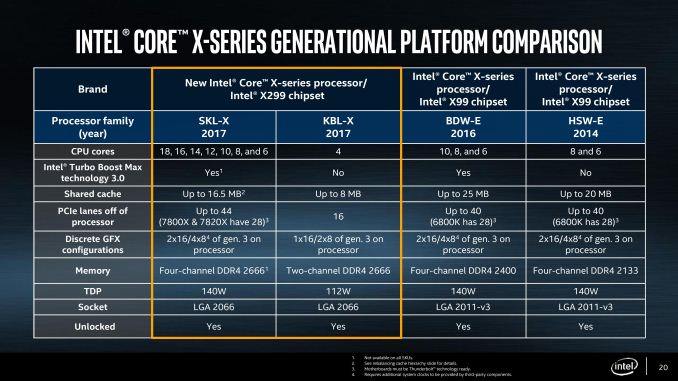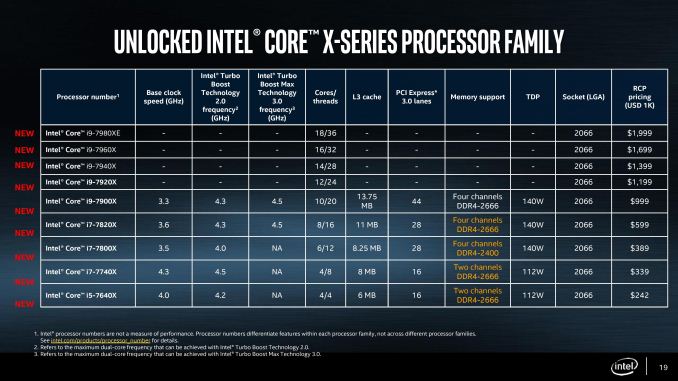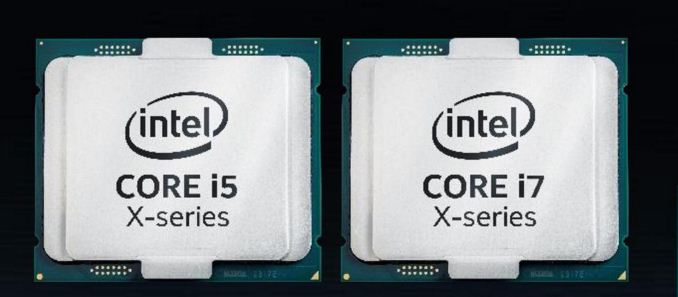The Intel Skylake-X Review: Core i9 7900X, i7 7820X and i7 7800X Tested
by Ian Cutress on June 19, 2017 9:01 AM ESTThe Basin Falls Platform: X299, SKL-X, & KBL-X
For most practical definitions of the Basin Falls platform, the X299 chipset is the heart. X299 supports the new processors, and like the Z170 and Z270 counterparts on the mainstream consumer line, is basically a big PCIe switch. One of the issues with the older X99 chipset was its limited capabilities, and inability to drive many PCIe devices – this changes with the big switch mentality on X299. For the DMI 3.0 link going into the chipset (basically a PCIe 3.0 x4), the chipset has access to up to 24 PCIe 3.0 lanes for network controllers, RAID controllers, USB 3.1 controllers, Thunderbolt controllers, SATA controllers, 10GbE controllers, audio cards, more PCIe slot support, special controllers, accelerators, and anything else that requires PCIe lanes in either an x4, x2 or x1 link. The total uplink is limited by the DMI 3.0 link, but there will be very few situations where this is saturated. There are a few limits to what support is available (some ports are restricted in what they can handle), and only three PCIe 3.0 x4 drives can use the in-built PCIe RAID, but this should satiate all but the most hardcore enthusiasts.
The Skylake-X family of processors for Basin Falls comes in two stages, based on the way the processors are developed. Normally HEDT processors are cut down versions of enterprise processors, usually through restricting certain functions, but the enterprise processors are typically derived from three different silicon layouts during manufacturing. Internally Intel call these three layouts the LCC (low core-count), HCC (high core-count) and XCC (extreme core-count), based on the maximum number of cores they support. Nominally Intel does not disclose which silicon layout they use for which processors, though it is usually straight forward to work them out as long as Intel has disclosed what the configurations of the LCC/HCC/XCC dies are. In this case, Intel has officially left everyone guessing, but the point here is that historically Intel only uses the LCC silicon from the enterprise line for its consumer desktop processors.
In previous generations, this meant either a 6, 8 or 10 core processor at the top of the stack for consumers, with lower core count models being provided by binning/salvaging imperfect CPUs. Each year we expected one of two things: the top-end SKU either gets more frequency, less power, or more cores, and as such the march of progress has been predictable. If you had asked us two months ago, we would have fully expected Skylake-X to top out with LCC silicon at 10 or 12 cores, depending on how Intel was planning the manufacturing part.
So the first element of Intel’s launch is the LCC processors, running up to 10 cores. We previously published that the LCC silicon was 12 cores, but we can now show it is 10 – more on that later. The three Skylake-X CPUs launching today are using LCC silicon with 6, 8 or 10 cores as the Core i7-7800X, Core i7-7820X and Core i9-7900X respectively. Intel is further separating these parts by adjusting the level of official supported DRAM frequency, as well as the PCIe lanes. We’ll go in a bit more detail further in the review.
The second element to the Skylake-X launch is the one that has somewhat surprised most of the industry: the launch will contain four processors based on the HCC silicon. Technically these processors will not be out until Q4 this year (one SKU coming out in August), and the fact that Intel did not have frequency numbers to share when announcing these parts shows that they are not finalized, calling into question when they were added to the roadmap (and if they were a direct response to AMD announcing a 16-core part for this summer). We’ve written a detailed analysis on this in our launch coverage, and we’ll cover some of the topics in this review. But Intel is set to launch 12, 14, 16 and 18-core consumer level processors later this year, with the top part running a tray price (when you buy 1k CPUs at a time) of $1999, so we expect the retail to be nearer $2099.
It should be noted that due to a number of factors, the Skylake-X cores and the communication pathways therein are built slightly differently to the consumer version of Skylake-S, which is something discussed and analyzed in this review.
The final element to the Basin Falls launch is Kaby Lake-X. This is also an aspect of the Basin Falls platform that deviates from the previous generations. Intel’s HEDT line has historically been one generation behind the mainstream consumer platform due to enterprise life cycles as well as the added difficulty of producing these larger chips. As a result, the enterprise and HEDT parts have never had the peak processing efficiency (IPC, instructions per clock) of the latest designs and have sat in the wings, waiting. By bringing the Kaby Lake microarchitecture to HEDT, this changes the scene, albeit slightly. Rather than bringing a new big core featuring the latest microarchitecture, Intel is repurposing the Kaby Lake-S mainstream consumer silicon, binning it to slightly more stringent requirements for frequency and power, disabling the integrated graphics, and then putting it in a package for the high-end desktop platform. There are still some significant limitations, such as having only 16 PCIe 3.0 lanes and dual channel memory, which might exclude it from the traditional designation of being a true HEDT processor, however Intel has stated that these parts fill a request from customers to have the latest microarchitecture on the HEDT platform. They also overclock quite well, which is worth noting.
The Kaby Lake-X parts will consist of a Core i7 and Core i5, both of which are quad core parts, with the i7 supporting hyperthreading. We have a parallel Kaby Lake-X review alongside our Skylake-X coverage, with some numbers from a stable 5 GHz overclock.













264 Comments
View All Comments
AnandTechReader2017 - Tuesday, June 20, 2017 - link
The Chill feature for AMD would probably be amazing for a mini-ITX build. Still waiting on AMD to launch dedicated graphics cards for laptops with it, would be amazing.I hope Nvidia comes up with a similar feature, would make gaming on laptops a lot nicer/quieter.
rocky12345 - Monday, June 19, 2017 - link
"As the first new serious entry into the HEDT space for AMD in almost five years, along with a new x86 core, AMD offered similar-ish performance to Broadwell-E in many aspects (within a few percent), but at half the price or better."Half right it was AMD's first serious entry into High end Mainstream Desktop in five years. We have not seem AMD's HEDT platform in action yet since it has not been released yet. With that said I was surprised how AMD's current Mainstream R7's were able to compete with Intels new HEDT platform so well. If this is what we are to expect from AMD's actual HEDT platform Intel will have a fight on their hands for sure.
I hope when AMD releases their Threadripper platform we get just as an extensive review for that as well. To me it is a lot more exciting to see x399 and threadripper in action than the x299 since Intel has been doing their HEDT platform for many years now and this will be the first time AMD has entered into the same Extreme high end space as Intel at the consumer level hardware.
Manch - Tuesday, June 20, 2017 - link
HEMD? LOLRyzen is a great chip no doubt. AMD is once again pushing Intel to iterate vs stagnate. AMD offers a great price/perf proc. But, AMD brought the comparison on themselves. Most previews were not against a 6700K or 7700K but against Intel's HEDT procs which AMD was clearly targeting with the pre-release benchmark comparos. It is not unfair to compare them.
Braincruser - Monday, June 19, 2017 - link
Any particular reason the mainstream intel processors are not in the benchmarks? One of the more important measurements for me is the difference between the mainstream and high end platforms.Ryan Smith - Monday, June 19, 2017 - link
While we technically have infinite space, we try not to overload the graphs with too many products, focusing on new products and certain generational comparisons. For specific comparisons you'd like to see that aren't in a graph, you can find all of that over in Bench.http://www.anandtech.com/bench/
AnandTechReader2017 - Tuesday, June 20, 2017 - link
Thanks for the link, I didn't know you guys had that.none12345 - Monday, June 19, 2017 - link
Small correction for your article, ryzen 7 has 20 pci lanes not 16. I am NOT counting 4 more for the chipset, if you count those its 24. Youve got 16 to the gpu, and 4 to a direct connected m.2(or 2 sata ports, but usually its a m.2)Tho thats not the whole story. Since technically you dont need the chipset, so you could connect something else instead on those 4 lanes. In the real world tho almost every motherboard will have a chipset there.
And then there are the usb ports which have direct connections on the chip as well. Thats could be counted as more pci lanes if one wanted to. They dont share the chipset link.
So depending on how you count it, its 20, 24, or 28 lanes. I would call it 20 and not count the usb or the chipset ones, but id definitly count the direct connected m.2
Nintendo Maniac 64 - Monday, June 19, 2017 - link
Uhhh, where's the results for Dolphin? It's on the "clock-for-clock" page but not on the "CPU system tests" page...Ro_Ja - Monday, June 19, 2017 - link
It's nice to see the Ryzen Chips keeping up with i9s.Hurr Durr - Tuesday, June 20, 2017 - link
Except they don`t, hence the price difference.